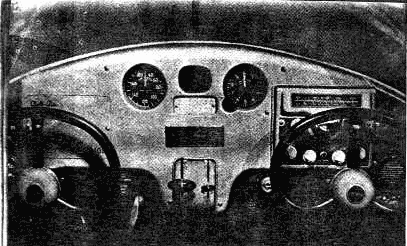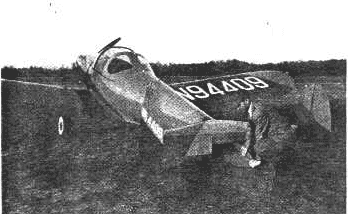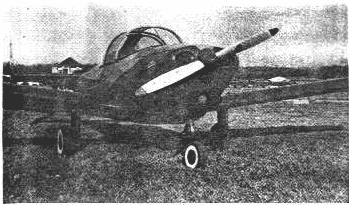Pilot's Report - NEW ERCOUPE
The Ercoupe for 1950 is available in two versions: regular two-control model or the standard three-control
By A.H. Hasbrook
INSTRUMENT PANEL has standard flight and engine gauges, allows for the installation of additional flight instruments.

Anyone who's ever had a hankering for an Ercoupe with rudder pedals and three control instead of the former two can now have his wish. Sanders Aviation, sole distributors of this spin-proof plane, are now producing a new three-control version of the 1950 Ercoupe in addition to the older two-control design.
This addition should not only interest those who have liked previous Ercoupe models but should also nullify the objections of some fixed-base operators who have shied away from using these low-wing airplanes for training because of the 'limitation' of the two control.
What's more, a rudder kit soon will be made available to anyone who wants to convert his older two control model to three control. The kit price will be somewhere around $150. Although the two- and three-control 1950 models, designated Club-Air, are essentially one and the same airplane, improvements have been engineered into both which are noteworthy and show a definite reaction to customer desire. These were brought to our attention by Joe Redding, Director of Sales and Service, during our recent visit to Riverdale, Maryland to flight check the new Ercoupe and report our findings to the readers of SKYWAYS.
The most obvious improvements, at first glance, is the appealing new color scheme with diagonal demarcation lines running from the top of the engine 'cowl on down the sides of the fuselage; on the fins and rudders; and on the wing tips. A two tone green are standard color schemes. In the near future there will also be a red-and-cream combination. Aside from adding materially to the appearance, this lacquer paint job aids in protecting the plane surface from 'weather'. Also improving the appearance of the airplane is a new Lucite bubble-type, one-piece windshield which increases the already excellent visibility and eliminates water leaks when flying in rain. Another external change is the redesigned elevator, cut partially away in the center to reduce its over-all area. The result of this change (in combination with an increase in 'up* travel of 7˚) has provided a control which gives less change in trim between full power and no power, with the elevators up any specific amount. This is most noticeable with the elevators full up where the difference in trim speed, power-on or power-off, is only two or three miles per hour, instead of about eight with the elevator. It also reduces yaw effect in rough air and increases the airplanes resistances to being slow rolled. Probably the most important result of this change, however, is the slower landing speed (approximately 5 MPH less) due to the fact that the tail now can be dropped down lower than was previously possible with the older models. Too, the 'V' cutaway in the elevator makes it relatively easy to posh the tail down by hand when moving the ship around in the hangar.
ELEVATOR Another Change in Ercoupe is the cut-away elevator that reduces its over-all area.

Walking around this neat, 'almost' all-metal airplane (its wings are fabric covered) , Mr. Redding directed our attention to the new radio antenna installation. It's a 'V' affair with the wires separating at the top rear of the cabin and running back to the top rear of the vertical fins. In this position they're completely out of the way when the pilot and passenger enter and leave this ship. Another improvement is a controllable cabin cold-air vent, screen covered, which is located in the face of the engine cowl where it can draw clean, cool air from the prop wash both while flying and on the ground. This in combination with the hot-air control (both control knobs are located close together at the right of the instrument panel) permits the occupants to select varying amounts of warm and cold air to 'air condition' the cockpit at will. During this SKYWAYS flight check, made at very low for-summer temperatures, the available hot air was quiet sufficient to maintain inside cabin temperatures at a comfortable level.
ENGINE COWLING can be held open by metal arm. No more will cowling come clunking down on the A&E's noggin

Using a dime to open the engine cowl's camlock fasteners, Redding pointed to what he called a 'scalp 'saver'. This is one feature that will be appreciated by pilots and mechanics alike. It is a metal arm device which, when opened, holds the engine cowl doors in an upright, open position even under very windy conditions. No more will the cowl come clunking down on a working A and E's dome. Another feature is the easily accessible quick-drain fuel strainer, positioned to direct waste gasoline away from the nose wheel tire. Too, cowling metal fatigue has been reduced by attaching all cowl supports directly to the fuselage, thereby maintaining the cowl in a 'floating' position, completely free of engine induced vibration. During this flight check, little vibration was noticed regardless of power application.
Continuing our inspection, we learned the Deluxe models (either two- or three-control) are powered by Continental 85 hp engines and have, as standard equipment, Sensenich 74-48 wood prop which are most efficient for over all operation. However, higher or lower pitch propellers may be used, depending the individual owner's climb or cruise desires. Either of two metal props (Met-L or Sensenich) or a Hartzell ground adjustable may be had on an exchange basis for an additional $85. Recently, an Ercoupe was tested with the new Munk Flex-o-Prop. Results showed better climb and cruising speeds.
The Ercoupe's nose gear appears to be very rugged and has a new forged 'nut cracker' to reduce maintenance. A two-bearing wheel replaces the single bearing job used on earlier models and carries a larger (500x5) tire. According to Joe Redding, the nose gear has been redesigned twice in previous years to increase its strength to offset the mishandling of some pilots who persist in diving the airplane into the ground while landing.
STANDARD TIRE on the Ercoupe is 500 x 5 tire. For rough or soft fields, a 600 x 6 tire and wheel assembly is available.

For anyone who finds it necessary to constantly operate from very rough or soft fields, a larger (600x6) tire and wheel assembly for an extra $60 on a new Ercoupe. This is the same size wheel used on the main gear. The kit includes a larger fork strut assembly to accommodate the increased tire and wheel size. In reply to our question concerning this larger tire size relative to cross wind landings, Redding said that except for smoother taxiing, there was no noticeable change in handling characteristics regardless of wind if landings are made at the minimum speed. One other nose gear change has been the elimination of the fairing that on previous models accounted for some maintenance costs.
Actually, we believe the looks of the airplane improved by this change. The main landing gear remains the same in design and appearance and continues to provide good, rugged service.

TAKE-OFF in the Club-Air was accomplished in 12 seconds from a standing start and crosswind. One minute 58 seconds later, the ship was at an altitude of 1000feet, its climb averaging out at 500fpm at 65 mph at 2175 rpm.
Before climbing into the Ercoupe, it was necessary to lower the two side panels which, when closed, meet at the very top of the cabin. Strong aluminum angle strips provide good finger grips and also serve to lock the cabin via padlock. This particular airplane had two-color, non-inflammable plastic covers on the seats, available to the prospective owner at an extra cost of $60. Although this price seemed high, we were assured there was very little profit in their sales. Seated in the ship, we were conscious of a difference in feel of the seat, as compared to the older models. Mentioning this, we learned the seats in the plane we were to fly were made of foam rubber, and that prospective customers now have a choice of two different seats, at no extra cost. One, the old standard high-back type; and the other, a low back seat that permits resting the arm over the top, and facilitates you're reaching the bottom of the baggage compartment. After trying both types, we expressed a preference for the high-back version - perhaps because your reporter is almost 6 feet tall and he found the short seat definitely uncomfortable.
The Ercoupe's baggage compartment is fairly large. It has a weight allowance of 75 pounds and can be used for luggage or cargo ... or, if you prefer, you can sit a child on the specially built 'junior' seat atop the battery case. In addition to the seat belt provided for this 'piggy-back' seat, there are tie-down straps for cargo or luggage.
In the upper rear wall of the compartment is a canvas 'sports tube' that will house a five foot fishing rod or anything else of a similar shape that has a maximum weight of five pounds. This is also an extra at $15.
Additional soundproofing material has been used in the cabin, including areas around the baggage compartment and under the rug type floor mat that has definitely improved the sound level.
The instrument panel has a thin metal overlay covering a center portion to within about 6 inches of the cabin wall. Aside from the pleasing decorative effect it provides a semi collapsible structure that would increase pilot and passenger safety in the event of a crash. Another safety improvement is the modified should 'chest harness which is available for $25. Inexpensive insurance, we think!
The standard flight instruments (airspeed compass and altimeter) are in the top center of the panel with room for 'extras' below. Engine gauges are to the left; switches, hot- and cold air controls and fuses are on the right. The mixture control knob, located on the lower left side of the panel is an angular affair while the carburetor heat knob, on the right, is conventionally round, thereby helping to prevent a pilot's working the wrong knob.
A Lear 1Xer two way radio is recessed into the right hand portion of the panel. A cabin speaker is available for $12.50. Just below the radio is the navigation light switch which also controls the indirect panel lights. The throttle and trim 'tab quadrant, although standard equipment as far back as the *47 model, is worthy of mention. Somewhat along the lines of an airliner quadrant, it permits easy and positive action and pre-setting of the throttle with reference to letters along its side. Too, once set, the throttle cannot creep! Frankly, we've wondered why other personal plane manufacturers haven't used this desirable type of quadrant.
A new gadget that should prove to be a boon to X-C pilots is the Trim-O-Matic control. Causing the ailerons to act as a big trim tabs, this device makes it possible to trim off wing heaviness due to uneven passenger, baggage or fuel loading. Hooked up to the aileron controls through a spring load arrangement, the adjusting knob is easily reached in its position midway between the left and right portions of the seat, near the floor. At the present time, the feature is standard equipment on the two-control model only. We hope it becomes standard on the three-control version. Another cockpit item that deserves mention is the new push-pull window lock, located on each side of the cabin, near the instrument panel. Operating on an adjustable cam principle, with small red actuating knobs, they are guaranteed not to take the skin off the fingers. The old style control wheel is still used, but we personally prefer the larger safety type wheel used in most of today's four place planes. An added stall 'resist' has been engineered into the elevator system which, safety wise, is worthy of note. This spring loaded device only makes itself felt when the wheel is pulled back far enough to slow the airplane o within about 10 MPH of stall speed. From this point rearward, the additional wheel force needed to slow the ship into the actual stall is considerable and cannot go unnoticed by the pilot. In fact this rear stage 'heaviness' is such that some pilots may subconsciously fail to get the wheel all the way back during their first few landings and will hit there-point instead of touching down the main gear first, as desired. However, this is easily overcome with a little practice. Although some experienced pilots may not appreciate this added elevator 'loading', we believe it is a good anti stall safety feature, particularly for student pilots. Completing our inspection of the cockpit area we noticed several other details. The ignition switch is of the key type, to the right of the throttle quadrant. There is a plastic sheet in front of the left wheel imprinted with the N-Number of the ship for ready reference when using the radio.
And the wing-tank gasoline gauge, on the left side near the floor, is illuminated by a recessed light when the nav' lights are switched on. In discussing the fuel system, Redding mentioned that the wing tanks are now vented internally, thereby permitting complete scavenging, or use, of their entire 18 Gallon contents. Another tank, holding an additional 6 Gallons, is located between the firewall and instruments panel and is equipped with a wire type sight gauge . An engine-driven fuel pump transfers the gasoline from the wing tanks to the fuselage tank. Redding stressed the point that when the wing tanks are empty and the first of the 6 gallons has been used from the forward tank, the sight gauge will drop to the mark, thus giving a positive indication of empty wing tanks and delivery of fuel from the forward one.